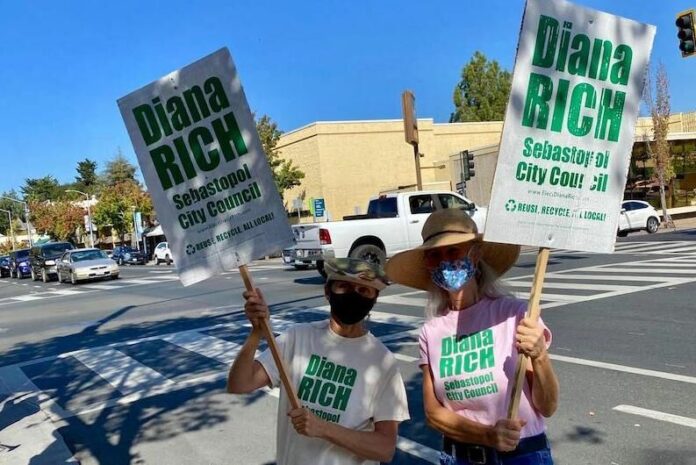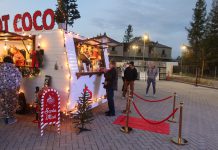
Political signs. You see them everywhere these days — in front yards, along Main Street, in the windows of houses, and, of course, being waved by supporters on Fridays at noon at the crossroads of Highways 116 and 12 in downtown.
That got us to wondering: just what goes into the making of political signage? We asked Sebastopol political consultant Dennis Rosatti and four of the candidates for Sebastopol City Council what went into their sign-making choices.
Diana Rich
First-time city council candidate Diana Rich, a retired attorney and former director of the Sebastopol Community Cultural Center, went all in with signs this season, and she helped make them by hand.
“Mine were individually silk-screened,” she said. “I was there helping do each one. We ‘sourced’ the cardboard from dumpsters. Yes, we went dumpster-diving. Who knew campaigning could be so … um … hands on and elegant? Then we cut each cardboard piece down to size, painted each side white, ran masking tape along the top edge and silk-screened each sign. It was a super fun project. My husband cut the stakes, and we assembled them all. And they’re all recyclable. So much work, but so right.”
“Patrick Amiot came up with the idea and was involved throughout. A talented young local woman did the silk-screening. Lots of volunteers made it happen. And the topper: they’ve survived since August, even through rain.”
“Of course it cost more than coroplast signs, but that’s the thing I’ve learned about principles. Sticking to your principles can be more challenging, but doing what’s right is generally worth the effort,” she said.
Rich said they made 174 small signs and 19 large signs. She said she carries a little sign repair kit in her car so she can fix broken signs when she sees them.
When a couple of her signs were stolen, Rich attached this reminder to her signs around town: “This sign is an expression of constitutionally protected free speech. It is the voice of the people who live here. The United States Supreme Court has recognized that yard signs placed on a person’s property are important because they are an easy and inexpensive way for citizens to participate in public debate. Political yard signs are protected by the First Amendment. Ladue v. Gilleo, 1994; Reed v. Town of Gilbert, Arizona, 2014. They are one of many free speech rights that we enjoy and celebrate in Sebastopol.”
Neysa Hinton
Councilmember Neysa Hinton is running for re-election this year, and she recycled the plastic signs from her previous campaign.
“I originally got my signs from Todd at Sky High Signs in Forestville in 2016,” she said. “Those signs four years ago cost approximately $10 per sign, including the metal stand. I saved and stored my old signs and had Ron Blair add the little yellow strip with the word “Re-elect” for 2020. He was able to update them on both sides with the little stripe for approximately $3 each.”
“He also updated my large signs with updated labels that say ‘Re-Elect’ and ‘2020.’ I have only six large four-foot by four-foot signs (as I had in 2016). Personally, I think that is more than enough large signs in our community.”
“People laugh when they drive through my neighborhood because of all the ‘Re-Elect Neysa’ signs,” Hinton said. “I always laugh when I hear this and say that those are some of the most important endorsements you can get — when your own neighbors support you and vote for you!”
“As I did last year, I will take the day off from work and pick up all my political signs on the day after the election. If I miss one, I encourage residents to call me for a pick-up.”
Michael Carnacchi
Councilmember Michael Carnacchi, who is up for re-election this year, is running an extremely low profile campaign — no website, no election-year Facebook page (though he does have a personal Facebook page), no flyers — and no yard signs, except for those his supporters make by hand, which he appreciates.
Speaking of the sign above, he said, “The handmade campaign sign was made by one of our constituent’s grandchildren, who did it of their own accord. Since I do not have any control of that, yes, I am okay with it.”
Evert Fernandez
First time candidate Evert Fernandez, a Sebastopol financial planner and head of the city’s planning commission, had his signs printed at a union shop in the Bay Area. He has over 250 signs posted around Sebastopol.
Fernandez’s campaign consultant, Dennis Rosatti said, “The signs are screen-printed on cardboard that is fully recyclable and sustainable. They could be used as a sheet mulch, or composted or recycled.”
Rosatti said he even re-uses the wires from the signs. “The wires are also good for gardening props,” he said. “I have two in use in my garden still for my tomatoes.”
Do political signs work?
Rosatti, who has worked on several political campaigns in west county over the last few years, said political signs boost a candidate’s name recognition and help establish neighborhood presence.
“Signs don’t win campaigns,” he said, “but they do show a level of support for a candidate in a physical, visual way.”
“In larger areas, yard signs are more of a supporter/volunteer engagement tool. It feels good to plant what you believe in your yard for a few weeks 250 signs in the field. It’s like a temporary social media profile photo, but old school and ‘in the flesh’ if you will.”
Rosatti said signs act as “visual endorsement influencing.”
He said a neighbor might see the sign and ask a question, or just think, ‘If my neighbor is supporting so-and-so as a candidate, that’s enough for me.’
Rosatti said he tries to avoid plastic, called coroplast, signs as much as possible to keep plastic out of the waste stream, but sometimes he makes exceptions.
“For example, the larger highway sign (two-foot by four-foot, four-foot by four-foot, four-foot by eight-foot) sizes are only mass produced in coroplast plastic, due to need to be mounted on t-posts and fences, as well as wind durability and weather as well. There are some coroplast signs that are No. 5 plastic and are recyclable as a result.”
Rosatti said he’s also careful where he has his signs made.
“To go with local union labor is not cheap,” he said. “You can go on the internet and buy signs made in Texas or China for very cheap, but the exploitation factor of those workers is not something I’m comfortable with. I also try to direct campaign money as much as possible into the local economy, to union printers and small print shops and keep those dollars circulating right here in Sonoma County and the Bay Area.”
Townsy is a recently-launched community app, offering local news, online shopping at local stores, a local event guide, local volunteer and job boards and more.
Sonoma West Publishers is partnering with Townsy to make our news more accessible to the Sebastopol community.







